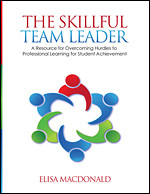The Skillful Team Leader: Overcoming Hurdles to Professional Learning
The Skillful Team Leader: A Resource for Overcoming Hurdles to Professional Learning for Student Achievement
by Elisa B. MacDonald
(Corwin Publishers/Learning Forward, 2013 – Learn more)

Recently, I have been completely absorbed by how we as human beings use words to communicate. Words and their meanings are always evolving as language morphs and culture changes. This is evidence that we are constantly growing and being transformed as we learn about new things and these new things become commonplace.
On one specific day, as I was contemplating the jargon that is such an important part of the educational arena, The Skillful Team Leader; A Resource for Overcoming Hurdles to Professional Learning for Student Achievement by Elisa B. MacDonald (Corwin 2013) came across my desk.
The word Hurdle in the title jumped out at me.
So, what exactly is a hurdle? I went to my favorite resource: Google. Accordingly, a hurdle is an “obstacle or difficulty, a problem, barrier, snag, a stumbling block or an impediment, an obstruction or a complication.” It can even be called a “headache or a hiccup!” In short, it’s something that blocks one from achieving success in a specific venue.
For me, as an educator, a hurdle represents a challenge to overcome, an opportunity to grow and stretch — not only an opportunity for adult administrators and teachers, but also for the child and student. Hurdles are good when they are approached with a positive attitude and a vigor that looks with eyes that see that “everything can be overcome.”
More about the book

“…listening to team leaders’ dilemmas and reflecting on my own. It comes from mulling over moments when my response succeeded in overcoming a hurdle to team learning or unintentionally created another. It comes from an ongoing quest for practical solutions grounded in theory and research. It comes from the belief that although hurdles can seem impossible to move past, they can in fact be catalysts for greater learning when we approach them skillfully.” (pg. 3)
MacDonald’s book is divided into two sections.
Part I: Foundations gives the reader a resource for leading groups of educators through processes to increase student achievement. It focuses on the common ground that all educators hold true: Values, mindset, intelligence and skill.
Values ground the leader in the belief of what is truly important. MacDonald lists five: collaboration, shared leadership, goal setting and attainment, rigorous discourse, and continuous improvement. A mindset is what the educational leader believes in her core about student’s capacity to learn which directly impacts effectiveness in the classroom. Intelligence is as MacDonald describes it, “not IQ but EQ. It is the ability to be attuned to and respond to emotions in self and others.”
And finally, skill: “a skillful approach to overcoming hurdles requires a team leader to anchor her leadership in the five foundational values (listed above)…to hold the mindset that every teacher has the capacity to learn and change, and to read and respond effectively to the emotional climate that a hurdle creates.”
MacDonald proposes three steps that skillful leaders can use to overcome obstacles: identify the hurdle, explore possible causes, and select the most appropriate measured response, given the situation. MacDonald offers many possible responses to potential hurdles throughout the book.
Overcoming the hurdles
In Part II: Hurdles, MacDonald illustrates each of the core values and describes the barrier to establishing that value, in the context of school culture. Hurdles are the pushback on what the values represent. Each chapter in Part II defines a value, explains why the value is important, and then describes nuisances associated each hurdle. MacDonald tells us how these values (as well as the hurdles) affect school culture and offers an action planning tool that the leader can share with her team to discuss not only the values but also the barriers listed.
In the final chapters, MacDonald shares resources such as surveys, charts and team experiences which bring home the content that she describes in each chapter.
As readers work their way through MacDonald’s clear and compelling discussion, the book becomes a powerful resource through which we can actually understand how, with insightful leadership, teams can overcome barriers to collaboration and change the entire learning environment for the better.
~ Read an interview with Elisa MacDonald ~
Three reasons to keep leading
MacDonald concludes with some personal remarks that speak to the value of leadership even when the challenges are great and the hurdles frustrating. She offers three reasons why she continues being an educational leader and explains the benefits of actually struggling through each obstruction that is described in the previous pages.
One reason, she says, is personal learning and growth. “With each hurdle I encounter, I better understand the complexity of leading. I learn how to anticipate and avoid; I learn how to effectively respond.”
MacDonald’s second reason is Teaching. Within this description, I deeply appreciate her representation of true collaboration, which is often not easy and can be quite messy.
“I discover a more impactful way of reaching students when a colleague suspends my assumptions and prods me to think deeply about my practice, when my words or actions have an impact on someone else’s beliefs about him- or herself as a teacher, when I know I’m contributing to a professional learning culture, and, above all, when my colleagues and I motivate one another to continuously learn and change in order to be our best selves.”
The first and primary reason to continue to work with teams, according to MacDonald, is to benefit students. “Seeing the impact of my team’s learning on students keeps me motivated to continue leading adult learners.”
Her sentiments remind me of what Maya Angelou says about hurdles. “Love recognizes no barriers. It jumps hurdles, leaps fences, penetrates walls to arrive at its destination full of hope.” Doesn’t that explain it all?
Geralyn Schmidt, Sister of Christian Charity, is the Wide Area Network Coordinator at the Diocese of Harrisburg, Pennsylvania. She is responsible for professional development programs for every age learner. An educator for 28 years, Sister Geralyn blogs for Voices from the Learning Revolution.

































